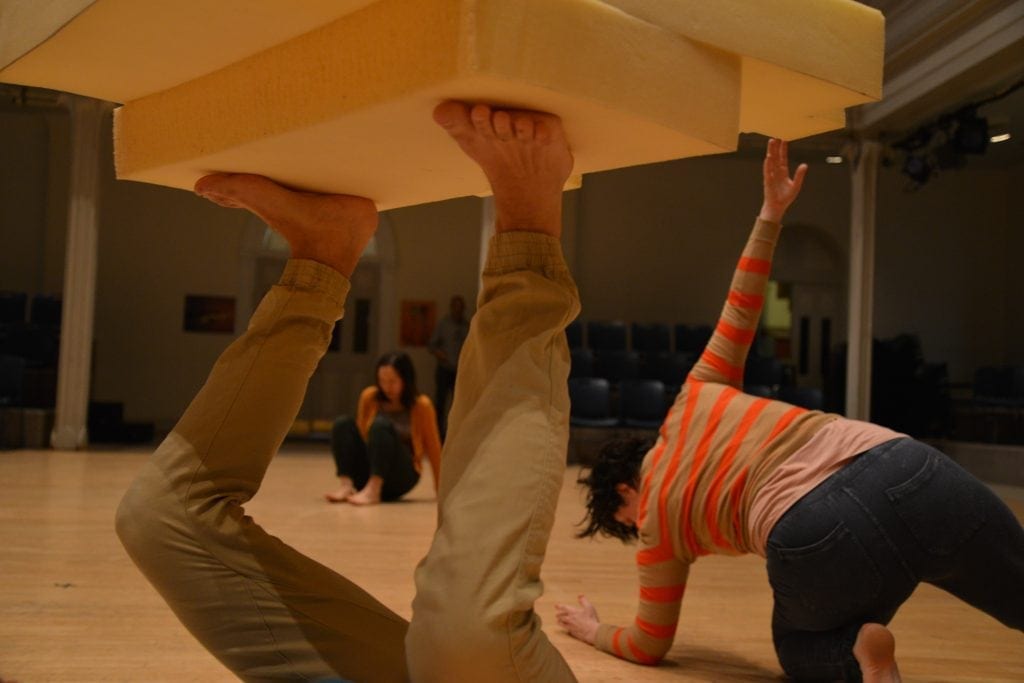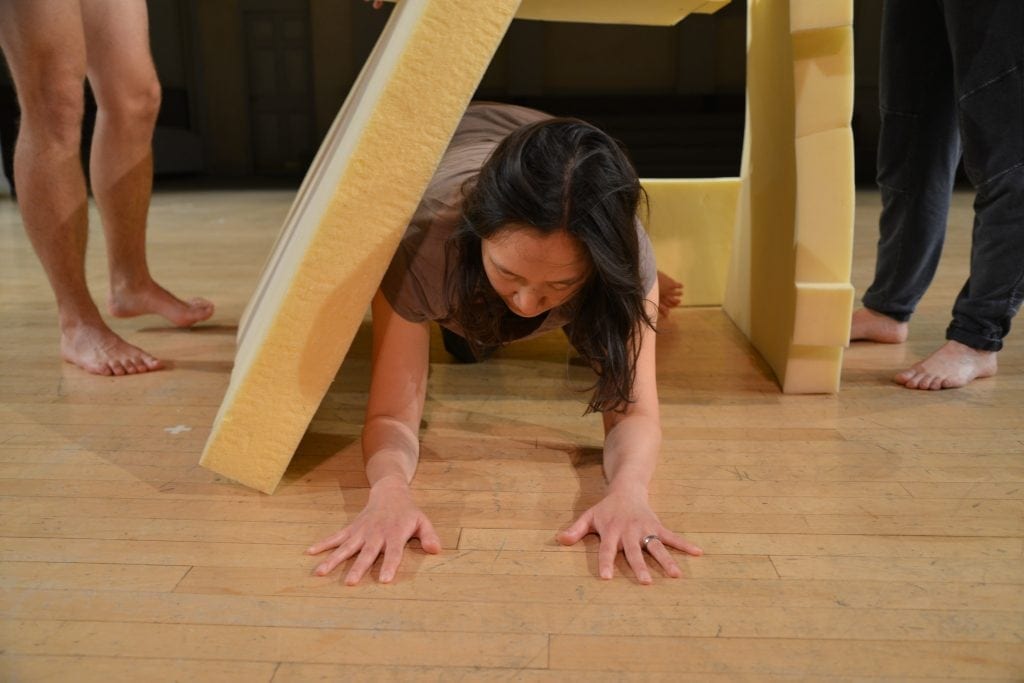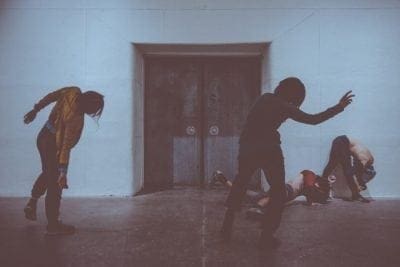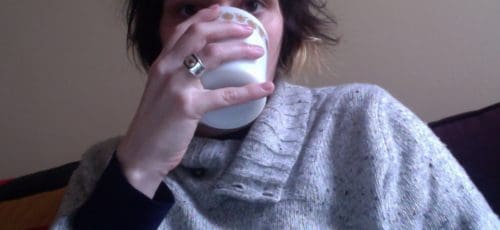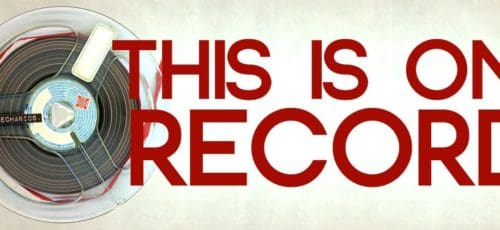What’s Going On Underneath: Meg Foley on The undergird
“The goal is to touch without touching—like really feel and be moved to tears among this long landscape of talking about what our bodies are doing, what we imagine they could do, and about death/loss/grief.” Meg Foley
For the last seven years Meg Foley has been experimenting and and refining her improvisational performance practice, “action is primary”. For a year, she paused every day at 3:15pm to dance, wherever she was, embracing the practice’s central tenet to “hold what you are doing at the center of what you are doing, even as slips towards new centers.” After developing the practice individually, she began to investigate how it could be used to make a group dance.
 Foley’s entry into the 2018 Fringe Festival, The undergird is a four-person piece which explores the artists’ “felt experiences” of grief and death in a rhythmic celebration of where memory and imagination live inside the body and how they can be remade through movement. FringeArts talked to Meg about her intriguing title, performance practice, and process.
Foley’s entry into the 2018 Fringe Festival, The undergird is a four-person piece which explores the artists’ “felt experiences” of grief and death in a rhythmic celebration of where memory and imagination live inside the body and how they can be remade through movement. FringeArts talked to Meg about her intriguing title, performance practice, and process.
FringeArts: “The undergird” is an intriguing title. How did you come up with it?
Meg Foley: I knew I wanted to use action is primary, an improvisational practice I’d been developing and performing at that point for almost seven years, to make a piece about grief and my relationship to mortality/death, which at first I was like “oh duh, it’s about my Dad dying”. And it is, but quickly I realized it was about something much bigger. I started writing early on and a lot of other material—my experience as a parent and of child birth, my relationship with my mother, the feeling of my own skin—emerged.
I knew that I was trying to stay close to something that I was either pulling away from or avoiding; I was trying to move towards the center rather than away. And I think I had an image of cement and rebar and how it’s held together, a little bit like going down into the boiler room or something to get to where all the mechanicals are.
I think a lot about the action and embodied sensation of words and linguistics, and so it was very clear to me that the title of this piece was a noun. Also thinking about something stretching underneath, holding other things up, or a constant underpinning. Because right away when I started working on the piece, I started thinking about time as a primary material and research point and also thought about earth matter and our bodies as part of that, so in that sense The undergird is both sort of biological and emotional/personal in terms of what’s going on underneath and throughout all the time.
FringeArts: What was the original inspiration for the piece itself?
Meg Foley: I made a very large project in 2016 called Action is Primary, that was performances and a visual exhibition all centered around this practice I’d developed, action is primary. (You can read more about it on my website.) I had at that point been performing the practice for four years and had a lot of questions about choreographic structure in improvisation in relationship to embodiment and emergent states, sensations, visual evocations, etc.
I also had questions about whether it was possible to collectively make a group dance using a solo improvisational form, especially one like action is primary, which is very self-involved and totally self-determined in scoring in the moment of performance. I briefly dipped into this question specifically with a group piece that I sketched out in 2014, called Togetherish, kind of in the middle of my long research period into action is primary.
Anyway, I felt like in this particular, cumulative iteration of Action is Primary, I was constantly moving away from something. My performances felt awful. It was like I was trying to escape the moment, or my own embodied experience, which was the opposite of almost all the previous experiences I had had performing the practice. So I wanted to know what happened, what had was at the center, what was the thing I was overwhelmed by and not looking at, moving away from, or not saying. Then I had an image of Annie Wilson standing a top a mound yelling this speech, angry at the audience for not being able to feel the inside of her elbow, for not being able to understand the reality of her body, for the failure to communicate it. So then I was like, ok, I want to improvise a speech about my relationship to mortality and it starts with this image.
At some point in developing that—and this I don’t remember either which is unusual for me frankly—I realized that The undergird was at the center of — or fascial even, woven through and really within—Togetherish as well—this piece about how we have relationships, how they don’t match or fall apart or are glorious. So I had this image of making a group dance where the dance itself is the soloist—so the piece has an embodied presence similar to the experience of building a solo and radiates out from the center, without a front or a beginning or an ending. And I posited that this could only be possible if each of us was self-determining simultaneously but considering the group as inextricable from our experiences and definitions of ourselves—this is a question we are looking at, kind of examining notions of togetherness as something to be taken apart with and around definitions and charged experiences of grief. In writing that, I suppose I wanted to raise the stakes.
FringeArts: What do you see as some of the pitfalls you hoped to avoid in art that deals with grief? How did you seek to avoid them?
Meg Foley: I don’t know the answer to that question. I am in completely uncharted territory for me with the intentional personal subject matter of the work but working with tools that I know quite well. I have big questions about how explanatory or vague I want to be maybe and know that the intention of the piece is to stay close to the sensation of considering your mortality and experiences of loss, if that makes any sense. So grief is really not just utilized subject matter but rather felt material that we are trying to address through a lot of different tactics — explicitly telling a story, poetic imagery, time-based tasks, non-linear storytelling, emotional states. The goal is that when we weave them together, the whole of the dance manages to touch on the possibility of closeness with others and on the sort of (potentially) desperate, existential experience of loss and aging/changing bodies through many different tellings and understandings. Because any time you try to put it into words, it fails. But when we do it together there is something ritualistic and exultant about it — in that way our process is very driven by emotional need as a choreographic and process structure: consent practices, beginning and ending rituals, i.e., ways that we take care of ourselves and each other in the process. We are intentionally considering how we build the group, and thus, the dance.
FringeArts: How did you choose your collaborators? What did you want them to bring to the project?
Meg Foley: All three of my performer-collaborators are people I’ve worked with before and who have worked with the action is primary practice before. All three were in some version of Togetherish. Annie participated in the large scale Action is Primary project, and she performed Lay of This Land (the performance of action is primary pre-Action is Primary) when I was too pregnant to perform.
Each of them reframes the practice for what they need and really dig into the implications of it in a way that drives me as a maker. I am not interested in making work where the performers do not have a say, and I actively pursue individual performative experience as a formal material and structural determination.
I asked them to bring their full commitment to the work, which includes opportunities for dissent and disagreement as an opportunity to build. I asked them to bring their stories and their identities to the table as creative material but was also explicit in that in doing so, I would not just take their material and organize or frame it. In that sense the direction of the piece is truly collaborative. I do not want to assume that my position on something they have brought the to table is the appropriate way to include it in a performance. This is an active and ongoing conversation and is influenced by my experience in social therapy, a therapeutic form that considers the group the unit of development, as opposed to the individual. In social therapy we talk a lot about how to be giving is to all be clamoring to share and that when you share, the reality or narrative of the experience changes because it opens to involve other people and their responsive experiences, whether or not it seems relevant or relatable at the outset.
FringeArts: What introductory conversations did you have with the ensemble as you were developing this piece?
Meg Foley: We began the process quite open—I had a lot of goals but not a clear sense of how the process might meet them. We talked about each of our goals and the conditions we would need to meet them as a way to frame our time together. We each talked about our particular experiences of grief. I introduced the various practices, most of which were developments of the action is primary practice.
FringeArts: How has your view of the project changed over its development?
Meg Foley: I’m really inspired by the closeness and connection the group is building. We have a lot of fun, we get super sweaty, we share a lot, and we feel a lot of feelings. Ha ha. At the beginning we began doing these daily dances as a way to warm up and tune to one another. They were bizarre and unexpected.
The thing that is really rising to the surface is structure—the ways of putting something together. We’re also talking about dancing as a value—as a thing—a proof of yourself, moving to the edges and then pressing your edges past yourself. It not having a beginning or an ending. We’re discussing goals of particular practices and what is foundation, and readjusting practices based on performer need.
FringeArts: What is the role of the audience in this work?
Meg Foley: The audience is super involved in the piece, and understanding how we consider and include them is a part of each practice that we do. The piece is intimate, emotional, and physical and includes the viewer in the consideration of environment and the group of the room. We try to read the room—look at the audience, talk to the audience, and see ourselves as constantly in relation. In doing this, we are equally taking care of ourselves being witnessed with what we’re giving and trying to take care of the audience by expressing gratitude for the presence of their live bodies.
One of the central practices culminates in directing attention at the viewer and describing touching them through words. The goal is to touch without touching—like really feel it and be moved to tears by it as it happens among this long landscape of talking about what our bodies are doing, what we imagine they could do, and about death/loss/grief, and amazingly enough, it happens. It’s like the floorboards lift up and the space becomes so full with drummed up emotion and sensation and image that a path is built to touch each other without touching, to really feel the contact of active relationship. We try to bring them with us, wrap our sensations around their bodies, and hopefully include their sensations and stories. Since most of these practices were developed for solo performance, that’s a very different relationship to the viewer that we are trying to figure out, literally right now in the rehearsal process. It may be that the front row is told that by sitting there they are consenting to our direct attention, so the audience has say in how implicated they want to be. But it’s all driven by the practices themselves and what kind of attention and awareness each performer holds within each practice. The same attention we give to ourselves, we give to each other and to the audience as well. So with the choreographic structure, it fluctuates, just like any relationship.
Natalie, the lighting designer, will be seated amongst the audience and will be both running lights and performing text from there. It is my hope that this placement both brings Natalie into the construct of the group and by literally reaching the edges of the performance to the back of the audience, will create an environment that the audience truly feels a part of.
—Christopher Munden
What: The undergird
When: September 13–16, 2018
Where: Icebox Project Space, 1400 North American Street
Cost: $15–$29
Created by Meg Foley, Drew Kaiser, Jungeun Kim, Annie Wilson, and Natalie Robin


